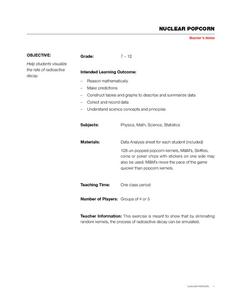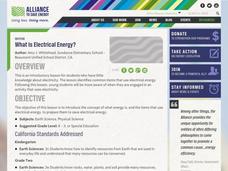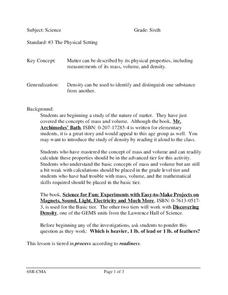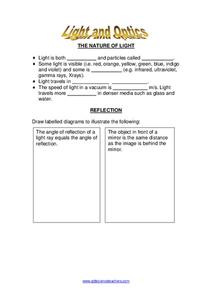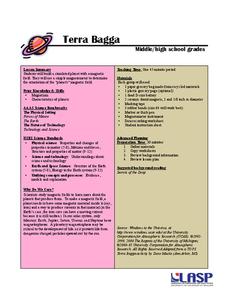National Museum of Nuclear Science & History
Nuclear Popcorn
Make your instructional activity on radioactive decay pop with this lab exercise. Using popcorn kernels spread over a tabletop, participants pick up all of those that point toward the back of the room, that is, those that represent...
Curated OER
Mice Rule!
Learners explain what biodiversity is and how adaptive features are maintained in a population. For this biodiversity lesson students complete a simple activity involving mouse populations.
Mr. E. Science
The Nature of Electromagnetic Waves
Imagine a presentation that covers electromagnetic waves, electromagnetic radiation, radio waves, microwaves, the visible light spectrum, UV, X-ray, and gamma rays. Here's one. Packed with facts and colorful illustrations, 11-slide...
PHET
Earth’s Magnetic Field from Space
Feel the pull of science! The final installment of this 18-part series is an application of everything learned in the previous high school lessons. Scholars are given a magnetic field map and must propose an arrangement of magnets that...
Curated OER
Human Evolution: Biology, Bones
Learners will love a weeks worth of bone study. They use bones and characteristics of bones to explore the evolution of hominoids. Bones are compared, categorized, and considered. A great way to bring physical anthropology and material...
NASA
Cosmic Microwave Background
Begin your next class with a BANG! Pupils discuss the formation of our universe and its expansion before proceeding with an activity designed to demonstrate what most likely occurred billions of years ago. They conclude with a discussion...
Virginia Department of Education
The Law of Conservation of Matter
The Law of Conservation of Matter can be complex for young scientists to fully grasp. Use this experiment to help simplify the process as pupils perform two experiments to determine mass: one that melts a substance and the other that...
Curated OER
On The Go! Forces and Motion
Young scholars create a car using physics. In this forces and motion instructional activity, students create a car and test which changes in design change the performance of the car. Young scholars complete a graphic...
KOG Ranger Program
Fire Behavior in Forests
Understanding the ways a fire will act is a key factor in fire safety and fire prevention. Young campers focus on how the weather and terrain can affect the behavior of a fire with topographic maps and different...
Curated OER
The Physics of Hummingbirds: Magic in the Air
Students study hummingbirds and how they use Newton's law. In this motion lesson students complete several activities and view videos of hummingbirds.
Science 4 Inquiry
An Investigative Look at Florida's Sinkholes
In May of 1981, the Winter Park Sinkhole in Florida first appeared and is now referred to as Lake Rose. Scholars learn about the causes of sinkholes through an inquiry project. Then, they analyze recent data and draw conclusions to...
Curated OER
Fossil Fuels (Part II), The Geology of Oil
More of a mini-unit than a lesson, these activities lead inquisitors through a survey of oil deposits. In the first part, they read about and view diagrams of sedimentary rock layers that trap oil. Next, they test porosity and...
Curated OER
Environmental Science/Water Pollution
Students study natural habitats, aquatic life, renewable and non-renewable resources. They discuss conservation efforts for sea otters and desert toad in this units.
Curated OER
Science - Kinds of Materials
In this science worksheet, learners answer 10 true or false questions about kinds of materials and their characteristics. They complete a chart by naming 4 different materials, naming an object made from that material, and indicate one...
Curated OER
What is electrical energy?
Learners distinguish between items with and without energy. In this energy lesson, students understand that natural resources power electrical apparatus and that energy needs to be saved.
Curated OER
Naturally Magnetic Elements
Pupils explore naturally magnetic elements. In this magnets lesson, students examine the periodic table of elements. Pupils discover the parts of an atom and determine which three elements are magnetic.
Curated OER
Nature And Nurture
Students develop an understanding of the role both nature and nurture play in determining an individual's traits. Using a website, students answer questions about nature and nurture in order to solve the riddle, What do you call a smart...
Curated OER
Physical properties of matter
Sixth graders find the physical properties of matter. In this matter lesson, 6th graders measure mass, volume, and density. Students are broken into 3 tiers with 3 different activities based on their understanding of mass and volume.
Curated OER
Light and Optics
In this light and optics worksheet, 11th graders fill in 7 blanks about the nature of light, draw 9 diagrams to illustrate reflection, refraction, lenses and color.
Curated OER
Help I've Fallen And I Can't Get Up
Young scholars examine how natural disasters impact humans and how to develop a disaster relief plan. They develop a list of natural disasters, and in disaster relief teams, create an emergency plan for their families to follow if a...
Curated OER
Be a Watershed - Create a Living River
Students investigate water ways by conducting an experiment with classmates. In this natural resources instructional activity, students define a watershed and identify where large ones are located within the United States. ...
Curated OER
Sexual Selection in the Animal Kingdom
Students research how sexual selection plays a role in driving evolution. They experiment how variation exists within not just obvious physical traits, but metabolically and behaviorally. They write a letter describing a problem, and a...
Curated OER
Genetics
Comprehend that many human characteristics-all physical traits and possibly many personality traits-are determined by our genetic makeup. These activities demonstate that all physical traits are genetically determined, some evidence...
University of Colorado
Terra Bagga
One way to identify possible volcanic activity on other planets is by testing the planet for magnetism. A science lesson begins with pupils constructing their own planet from a dead battery, magnets, paper, and tape before labeling...


